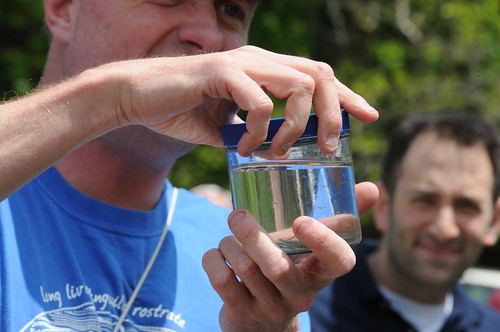FOR IMMEDIATE RELEASE 16-41 May 12, 2016 Contact: deppressoffice@dep.nyc.gov (718) 595-6600 Staten Island Students and Cub Scouts Take Part in Annual Eel Count at Richmond Creek BluebeltContinuing Expansion of Staten Island’s Sewer System and the Inter-Connected Network of Bluebelts Have Improved Water Quality and Created Habitats for Eels and other SpeciesPhotos of the Event are Available on DEP’s Flickr PageThe New York City Department of Environmental Protection (DEP) and New York State Department of Environmental Conservation (DEC) on Wednesday hosted students from the Saint Clare School and Cub Scouts from Pack 25 for the annual count of juvenile glass eels at Staten Island’s Richmond Creek Bluebelt. The American eel is born at sea, floats to the coast on prevailing currents and migrates to clean, healthy waterways along the east coast where they can live for up to 20 years. Eel populations are an important indicator of water quality and experts have seen a resurgence in the eel population in New York City following the investment of more than $10 billion over the last decade to improve harbor water quality. Thus far in 2016, more than 6,000 glass eels have been counted in Richmond Creek. “Fostering in our children an appreciation for the waterways that flow throughout the city is a wonderful way for them to both learn about the complex ecosystem that sustains many different species and to instill a lasting sense of environmental stewardship,” said DEP Acting Commissioner Steven Lawitts. “Our waterways our healthier than ever thanks to investments made in wastewater infrastructure, and this eel count serves as a wonderful opportunity for students to see firsthand how wildlife is thriving in New York City.” Each spring eels arrive in estuaries like the Hudson River as translucent, two-inch long “glass eels.” As part of ongoing research, volunteers and students use a ten-foot cone-shaped net specifically designed to catch the eels and then count and release them back into the water. The 2016 eel monitoring program began in March and will continue until the end of the eels’ migratory period. Staten Island is one of ten sites, ranging from New York City to Albany, where counts are taken as part of DEC’s Hudson River Eel Project. In 2015, about 4,800 glass eels were observed in Richmond Creek and nearly 50,000 were counted at the ten Hudson River Estuary monitoring sites. Eel populations had been in decline along the east coast of the United States for decades due to a combination of over fishing, water quality degradation, and man-made barriers to migration, such as dams. Over the last decade, DEP has invested more than $10 billion to upgrade sewers and wastewater treatment plants to improve the health of New York Harbor and local waterways. On Staten Island, DEP has connected thousands of homes to the City’s wastewater treatment system, eliminating the need for septic tanks, and preserved or constructed more than 60 Bluebelt wetlands to reduce roadway flooding and improve harbor water quality. The Bluebelt program preserves and optimizes natural drainage corridors including streams, ponds and lakes. Stormwater is directed to the wetlands where it is stored and naturally filtered. In addition, the Bluebelts provide important open spaces and diverse wildlife habitats. Over the last ten years DEP has built Bluebelts for approximately one third of Staten Island’s land area. DEP manages New York City’s water supply, providing more than one billion gallons of water each day to more than nine million residents, including eight million in New York City. The water is delivered from a watershed that extends more than 125 miles from the city, comprising 19 reservoirs and three controlled lakes. Approximately 7,000 miles of water mains, tunnels and aqueducts bring water to homes and businesses throughout the five boroughs, and 7,500 miles of sewer lines and 96 pump stations take wastewater to 14 in-city treatment plants. DEP has nearly 6,000 employees, including almost 1,000 in the upstate watershed. In addition, DEP has a robust capital program, with a planned $14 billion in investments over the next 10 years that will create up to 3,000 construction-related jobs per year. This capital program is responsible for critical projects like City Water Tunnel No. 3; the Staten Island Bluebelt program, an ecologically sound and cost-effective stormwater management system; the city’s Watershed Protection Program, which protects sensitive lands upstate near the city’s reservoirs in order to maintain their high water quality; and the installation of more than 820,000 Automated Meter Reading devices, which will allow customers to track their daily water use, more easily manage their accounts and be alerted to potential leaks on their properties. For more information, visit nyc.gov/dep, like us on Facebook, or follow us on Twitter. | ||
